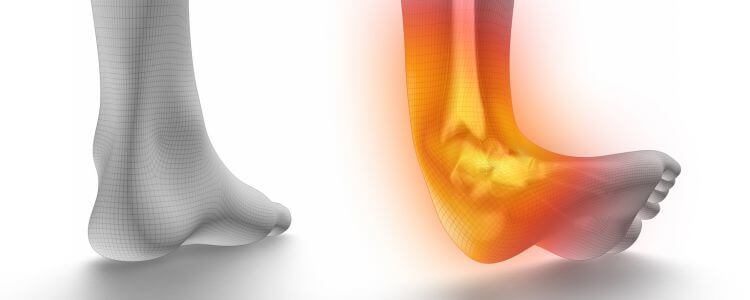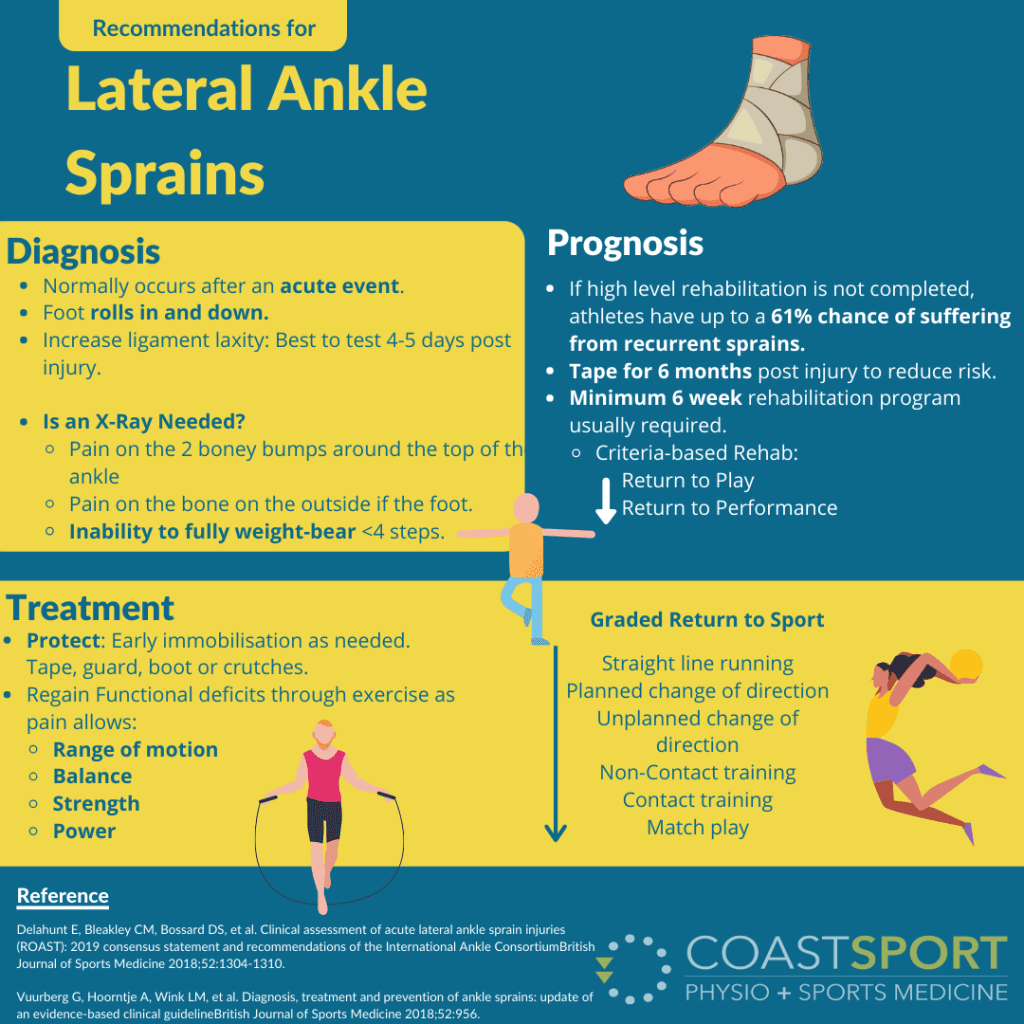
Ankle Sprain: How to Identify, Treat and Prevent Injuries
An ankle sprain is something most of us will have dealt with at some point or another in our lives — whether during sports or just navigating your daily routine. It’s one of those injuries that can throw a wrench into your plans pretty quickly. Understanding what an ankle sprain is, how to treat it, and how to prevent it can make a big difference in how you recover and get back on your feet.
At Coast Sport, we’re here to help you every step of the way, ensuring you get the best care possible to bounce back stronger. So here’s our rundown on everything you need to know about this injury.
What Is an Ankle Sprain?
So what exactly is an ankle sprain? In simple terms, it’s when the ligaments around your ankle get stretched or torn. Ligaments are those tough bands of tissue that connect bones to each other providing stability to your joints. When you twist or turn your ankle in an awkward way these ligaments can get overstretched or even tear — leading to a sprained ankle.
Ankle sprains can happen in different parts of the ankle; the outside, the inside, or across the top. The most common type is the lateral ankle sprain which affects the ligaments on the outside of your ankle. Knowing which part of your ankle is injured is crucial for proper treatment and recovery.
Common Symptoms of a Sprained Ankle
Recognising the symptoms of an ankle sprain early on can help you manage it better. Here are some common signs to watch out for:
- Pain – You’ll likely feel immediate pain where the injury occurred. It can get worse when you try to move your ankle or put weight on it.
- Swelling – Swelling around the ankle is pretty common and can develop quickly after the injury.
- Bruising – Discolouration might appear around the ankle as blood vessels get damaged.
- Tenderness – Touching the injured area will probably be sore.
- Limited Movement – Moving your ankle in different directions might be painful or difficult.
- Instability – You might feel like your ankle is weak or could give way, especially when trying to walk or stand.
- In severe cases, walking on a sprained ankle might be impossible without assistance.

Causes and Risk Factors of Ankle Sprains
Understanding what causes ankle sprains and the things that increase your risk can help prevent them.
- Inversion Injuries – This is the most common cause, where your foot rolls inward, stretching the ligaments on the outside of your ankle.
- Eversion Injuries – Less common, this happens when your foot rolls outward, affecting the ligaments on the inside.
- Rotational Forces– Twisting your ankle during activities like running or jumping can lead to a sprain.
- Direct Trauma – Dropping something on your ankle or landing awkwardly from a jump can cause a sprained ankle.
- Sports Participation -If you’re into sports that involve a lot of running, jumping, or changing direction quickly— like soccer, basketball, or gymnastics —you’re more likely to sprain your ankle.
- Previous Sprains – Once you’ve sprained your ankle, the ligaments might be weaker, making you more prone to future injuries.
- Improper Footwear – Shoes that don’t provide enough support can increase your chances of twisting your ankle.
By being aware of these causes and risk factors, you can take steps to minimise your chances of experiencing an ankle sprain.

Types of Ankle Sprains
Ankle sprains are categorised depending on which ligaments are injured and the severity of the sprain. Here are the main types to be aware of:
Anterior Talofibular Ligament Sprain
The ATFL is the ligament most commonly injured in a lateral ankle sprain. This type usually happens when your foot twists inward causing the ATFL to overstretch or tear.
Symptoms include pain on the outside of the ankle, swelling and difficulty putting weight on the foot. Treatment typically involves rest, ice, compression, and elevation (RICE) along with physio to restore strength and flexibility.
Calcaneofibular Ligament Sprain
The CFL is another ligament you’ll find on the outside of the ankle that can get sprained, though it’s way less common than an ATFL sprain. A CFL sprain often happens alongside an ATFL sprain during severe inversion injuries.
You might experience similar symptoms such as pain and swelling on the outer ankle. Recovery may take longer since multiple ligaments are involved and comprehensive physio is needed for full healing.
Posterior Talofibular Ligament Sprain
The PTFL is located deeper within the ankle and is rarely injured. A PTFL sprain usually results from high-impact trauma or extreme inversion injuries, often alongside other ligament injuries.
Symptoms include deep ankle pain, significant swelling and instability. Treatment typically involves immobilisation, physical therapy and sometimes surgical intervention to repair the damaged ligament.
Diagnosis and When to See a Specialist
Getting an accurate diagnosis is key to effective treatment. If you think you’ve sprained your ankle here’s what to do to stop it from getting any worse. A complete assessment by a physiotherapist or healthcare professional is necessary to diagnose an ankle sprain accurately. This usually involves:
- Discussing how the injury happened and any previous ankle issues.
- Checking the ankle’s range of motion, strength, balance, and ligament integrity through various tests.
- Sometimes, an X-ray or MRI is needed to rule out fractures or assess the extent of ligament damage. These tests support the clinical assessment and help in planning the right treatment.

Treatment Options for Ankle Sprains
Treating an ankle sprain begins with the RICE protocol to reduce any pain and swelling.
Rest the ankle to prevent further injury, apply ice packs for 15-20 mins several times a day, use compression wraps to control swelling and elevate the ankle above heart level to aid fluid drainage.
Over-the-counter pain relievers and anti-inflammatory meds can help manage discomfort, and in more severe cases, immobilisation with braces, splints, or walking boots may be needed to let the ligaments heal properly.
Rehabilitation is essential for a full recovery, involving personalised physiotherapy plans that include a range of motion and strengthening exercises to restore flexibility and muscle strength, as well as balance training to enhance stability and prevent future sprains.
Manual therapy techniques like massage may also be used to improve mobility and reduce pain. In rare instances where ligaments are severely torn, surgical intervention might be required to repair the damage, followed by a comprehensive rehabilitation program to ensure complete healing and restore ankle stability.
Preventing Future Ankle Injuries
Preventing future ankle sprains involves a combination of strengthening exercises, proper footwear, and adopting safe practices during physical activities. Implementing these strategies can significantly reduce the risk of re-injury and enhance overall ankle stability.
Here are some effective strategies:
Strengthening and Flexibility: Regular exercises to strengthen the muscles around the ankle and improve flexibility can enhance joint stability and reduce the risk of sprains. Key exercises include calf raises, ankle circles and resistance band exercises.
Balance Training: Incorporating balance and proprioception exercises into your routine can significantly reduce the likelihood of future sprains. Examples include single-leg stands and using balance boards or stability balls.
Proper Footwear: Wearing shoes that provide adequate support and fit well is crucial in preventing ankle sprains. Look for footwear that offers good arch support, a sturdy heel counter, and non -slip soles.
Warm Up and Stretching: Always warm up before engaging in physical activities to prepare your muscles and joints for the demands ahead. Incorporate dynamic stretches and gradually increase intensity to reduce the risk of injury.
Safe Training Practices: Adopt safe training practices such as gradual progression in activity intensity, using proper techniques during sports and exercises, and allowing adequate time for rest and recovery to prevent overuse injuries.
Taping and Bracing: Using ankle braces or taping can provide additional support during activities, reducing the risk of sprains, especially for those with a history of ankle injuries. Taping or bracing should be part of a comprehensive injury prevention strategy.
FAQs About Ankle Sprains

How long does an ankle sprain take to heal?
The healing time for an ankle sprain depends on the severity of the injury. Mild sprains, classified as Grade I, typically heal within a few days to a week with proper care and rest. Moderate sprains, or Grade II, may take several weeks to heal, requiring more intensive rehabilitation and possibly immobilisation. Severe sprains, known as Grade III, can take several months to fully recover and often necessitate surgical intervention and extensive physiotherapy. Following a structured rehabilitation program and adhering to medical advice can expedite the healing process and prevent complications.
Can I walk on a sprained ankle?
Walking on a sprained ankle depends on the severity of the injury. Walking may be possible shortly after the injury with appropriate support and pain management for mild sprains. However, weight-bearing activities should be limited for moderate to severe sprains to avoid further damage. In these cases, using crutches or a walking boot may be necessary until the ankle gains sufficient strength and stability. It is always important to consult a healthcare professional before attempting to walk on a sprained ankle to ensure it is safe and will not impede the healing process.
How to heal an ankle sprain fast?
Healing times for ankle sprains vary, but several strategies can speed recovery. Immediately using the RICE protocol— rest, ice, compression, and elevation —reduces swelling and pain. Gradually adding movement and weight-bearing activities under physiotherapist guidance promotes healing and prevents stiffness. Structured physiotherapy, a balanced diet for tissue repair, and protecting the ankle with braces or taping help avoid re-injury. Consulting a physiotherapist at Coast Sport offers personalised strategies for a safe return to activities.
How to exercise a sprained ankle?
Exercising a sprained ankle is essential for recovery and must be done carefully to prevent further injury. Initially, gentle movements like drawing the alphabet with your toe and toe raises help restore motion and strength. As healing progresses exercises such as calf raises and resistance band movements build muscle and ligament strength. In the later stages, balance training and agility drills enhance stability and prepare the ankle for activity. Always perform these exercises under a physiotherapist’s guidance to ensure safety and effectiveness.
Are Ankle Sprains Bad News?
Ankle sprains are little more than pesky injuries that may disrupt your daily life and sporting activities. But with the right approach, you can manage them effectively and get back to what you love doing.
At Coast Sport, our experienced physiotherapists are dedicated to providing personalised care to help you recover swiftly and safely. By following a comprehensive rehabilitation programme and adopting preventive strategies, you can reduce the risk of future ankle sprains and keep enjoying an active and healthy lifestyle.
If you suspect an ankle sprain, don’t hesitate to seek professional medical advice promptly to ensure the best possible outcome.
 Helping the Central Coast Feel Well, Move Well and Perform Well!
Helping the Central Coast Feel Well, Move Well and Perform Well!